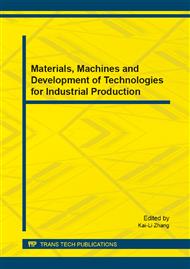p.362
p.367
p.376
p.380
p.388
p.392
p.397
p.401
p.405
The Application of External Drainage from Intestinal Cavity in the Surgical Treatment for Neonates with Necrotizing Enterocolitis
Abstract:
Object:To explore the feasibility and effects of external drainage from intestinal cavity in the surgical treatment for the neonates with necrotizing enterocolitis. Methods: A retrospective analysis was conduct on 22 cases of newborns with extensive and multiple intestinal necrosis found intraoperatively, all of which could not accept first-stage resected, treated by traditional operation or by external drainage from intestinal cavity between January, 2008 to January 2013. Duration of operation, amount of bleeding, and the survival rate after operation were compared between the two groups, which were divided by surgical methods. Results: No significant difference was observed in age, amount of bleeding and body weight (P>0.05) between the two groups. However, duration of operation and the survival rate after operation were significantly shorter in the patients by external drainage from intestinal cavity than the patients by traditional operation (P<0.05). Conclusion: To compare traditional operation or external drainage from intestinal cavity of necrotizing enterocolitis in neonates, a retrospective analysis conducted by us showed the feasibility and effects of external drainage from intestinal cavity of necrotizing enterocolitis in neonates, and a significant advantage in duration of operation and the survival rate after operation.
Info:
Periodical:
Pages:
388-391
Citation:
Online since:
August 2014
Authors:
Keywords:
Price:
Сopyright:
© 2014 Trans Tech Publications Ltd. All Rights Reserved
Share:
Citation:


